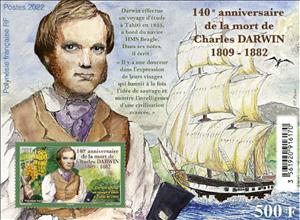Souvenir Sheet: Charles Darwin, 140th Anniversary of Death (French Polynesia 2022)
Charles Darwin, 140th Anniversary of Death (French Polynesia 2022)
19 April (French Polynesia ) within release Charles Darwin, 140th Anniversary of Death (2022) goes into circulation Souvenir Sheet Charles Darwin, 140th Anniversary of Death face value 500 CFP franc
| Souvenir Sheet Charles Darwin, 140th Anniversary of Death in catalogues | |
|---|---|
| Colnect codes: | Col: PF 2022-04SS |
Souvenir Sheet is horizontal format.
Also in the issue Charles Darwin, 140th Anniversary of Death (2022):
- Stamp - Charles Darwin, 140th Anniversary of Death face value 500;
- Mini Sheet - Charles Darwin, 140th Anniversary of Death face value 10*500;
- Souvenir Sheet - Charles Darwin, 140th Anniversary of Death face value 500;
Souvenir Sheet Charles Darwin, 140th Anniversary of Death it reflects the thematic directions:
A biologist is a scientist who conducts research in biology. Biologists are interested in studying life on Earth, whether it is an individual cell, a multicellular organism, or a community of interacting populations.They usually specialize in a particular branch (e.g., molecular biology, zoology, and evolutionary biology) of biology and have a specific research focus (e.g., studying malaria or cancer).
In botany, a fruit is the seed-bearing structure in flowering plants (also known as angiosperms) formed from the ovary after flowering. Fruits are the means by which angiosperms disseminate seeds. Edible fruits, in particular, have propagated with the movements of humans and animals in a symbiotic relationship as a means for seed dispersal and nutrition; in fact, humans and many animals have become dependent on fruits as a source of food. Accordingly, fruits account for a substantial fraction of the world's agricultural output, and some (such as the apple and the pomegranate) have acquired extensive cultural and symbolic meanings. In common language usage, "fruit" normally means the fleshy seed-associated structures of a plant that are sweet or sour, and edible in the raw state, such as apples, bananas, grapes, lemons, oranges, and strawberries. On the other hand, in botanical usage, "fruit" includes many structures that are not commonly called "fruits", such as bean pods, corn kernels, tomatoes, and wheat grains. The section of a fungus that produces spores is also called a fruiting body.
A landscape is the visible features of an area of land, its landforms and how they integrate with natural or man-made features. A landscape includes the physical elements of geophysically defined landforms such as (ice-capped) mountains, hills, water bodies such as rivers, lakes, ponds and the sea, living elements of land cover including indigenous vegetation, human elements including different forms of land use, buildings and structures, and transitory elements such as lighting and weather conditions. Combining both their physical origins and the cultural overlay of human presence, often created over millennia, landscapes reflect a living synthesis of people and place that is vital to local and national identity. The character of a landscape helps define the self-image of the people who inhabit it and a sense of place that differentiates one region from other regions. It is the dynamic backdrop to people’s lives. Landscape can be as varied as farmland, a landscape park, or wilderness. The earth has a vast range of landscapes, including the icy landscapes of polar regions, mountainous landscapes, vast arid desert landscapes, islands and coastal landscapes, densely forested or wooded landscapes including past boreal forests and tropical rainforests, and agricultural landscapes of temperate and tropical regions.



